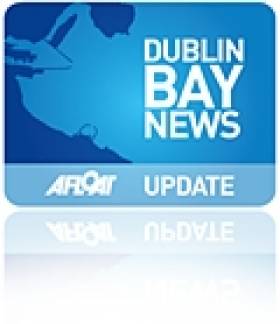Displaying items by tag: Irish maritime lectures
Lecture: Dublin Bay and the Kish Light
#LECTURES – Pádraig Laffan will present his lecture on 'Dublin Bay and the Kish Light' next Tuesday (20th March) starting at 8pm in the Foxrock Parish Centre. The Co. Dublin venue is located at the rear of the R.C. Church.
All are welcome to the lecture (admission €3) which is part of a monthly held talks programme run by the Foxrock Local History Club. For further information visit www.foxrocklocalhistory.ie/page7.html
Lecture: The East India Company in Kinsale
#LECTURE - This month's lecture organised by the Maritime Institute of Ireland (M.I.I.) is about 'The East India Company in Kinsale', presented by Paddy O'Sullivan.
The lecture will be held next Thursday (15th March) starting at 8pm and as usual takes place in the Stella Maris Seafarers Club on Beresford Place, close to Busaras and behind the Customs House.
O'Sullivan is an engineer, diver, author, and lecturer has uncovered a vast amount of information about the activities of the East India Company in Munster, regarding ship-building, trading, iron smelting, and cannon casting.
All are welcome to attend the evening where a bar and refreshments are available. A voluntary contribution is at the door. The organisers would be pleased for anyone to kindly forward details about the lecture programme, held monthly (third Thursday) at the city-centre venue.
Public transport: The nearest DART stations are Connolly Station and at Tara Street in addition to the LUAS (Red) line stop at Busáras. Car parking is located in the Irish Life Mall (ILAC) on Lower Abbey Street. For information of the lecture programme call 086 150 3766 and by visiting www.mariner.ie/lectures-spring-2012
Lecture: The Real Story of the ‘Kerlogue’
#LECTURES – The next lecture organised by the Ballybrack and Killiney Historical Society is tilted The Real Story of the Kerlogue, which was a small Irish coaster built in 1939.
She was owned by the Wexford Steamship Company and she rescued sailors during WWII (for more about the vessel click HERE) . The lecture is to be presented by Pat Sweeney. (starting at 8pm) and the venue is The Graduate Lounge (Upstairs) in the Killiney Shopping Centre on Rochestown Avenue.
All are welcome to attend the evening talk where there is an admission of €3 and for students and unwaged the admission is €2. For further information on the society lecture programme click HERE
Lecture: Building Dun Laoghaire Harbour
#LECTURE – This month's lecture organised by the Maritime Institute of Ireland (M.I.I.) is about 'Building Dun Laoghaire Harbour' and is to be presented by Colin Scudds.
The lecture next Thursday (16th February) starts at 8pm and as usual takes place in the Stella Maris Seafarers Club on Beresford Place, close to Busaras and behind the Customs House.
All are welcome to attend the evening where a bar and refreshments are available. A voluntary contribution is at the door. The organisers would be pleased for anyone to kindly forward details about the lecture programme, held monthly (third Thursday) at the city-centre venue.
Public transport: The nearest DART stations are Connolly Station and at Tara Street in addition to the LUAS (Red) line stop at Busáras. Car parking is located in the Irish Life Mall (ILAC) on Lower Abbey Street.
For further information and of the lecture programme, contact 086 150 3766 and visit www.mariner.ie/lectures
Lecture: The Very Strange Tale of the Ouzel Galley
#MARITIME LECTURES – This weeks 'Thursday' Night Talk organised by the Dun Laoghaire Motor Yacht Club (DMYC) is indeed about the very strange tale of the "Ouzel Galley".
Not many folk are aware that Dublin had its own maritime mystery that ranks with the Marie (Mary) Celeste saga.
In 1625 the Ouzel Galley sailed out the River Liffey bound for Mediterranean waters. After an absence of five years she returned battered and bruised confounding locals who had presumed she was lost with all hands.
It was not the unexpected return that caused excitement at the time but the contents of her hold!...Tim Magennis shall reveal more of this extraordinary story on the evening starting at 8pm.
Thursday's (9th February) talk is part of a winter series held at the DMYC and is open to non members who are most welcome. The club located on the West Pier, Dun Laoghaire Harbour is close to Salthill DART station. To contact the club Tel: 280 1371 and visit www.dmyc.ie
Lecture: ‘French Naval Expeditions to Ireland’
Lecture: The Vasa-Fifty Years On
The lectures are usually held on the third Thursday of each month and mostly in Stella Maris. The club is located between the Irish Life Mall car park (ILAC), the Customs House and Busaras. It is convenient to the Luas (Busaras stop) and the Dart (Tara Street station). For more information on visit www.mariner.ie/lectures
Dun Laoghaire Harbour's Sunday 'Family-Funday'
Opening times are 11am to 5pm and the entry fee is €3 for adults and children go free. The Funday is to help raise funds to support the local national maritime museum of Ireland in Dun Laoghaire. The Maritime Institute of Ireland is a registered charity, which run the museum through volunteers. In addition they host lectures, represent maritime interests and operate a museum and library.
The museum is housed in the former Mariners Church and is currently closed due to renovation and improvement works. There will be a 'soft launch' or 'preview' of the museum from October to mark the M.I.I.'s 70th anniversary.
Next year the museum is due to be officially re-opened during the Easter. The M.I.I. welcomes new members, volunteers and donations. For further information visit www.mariner.ie
- Pirates
- Carlisle Pier
- Dublin Bay News
- Maritime Institute of Ireland
- Dun Laoghaire Harbour
- M.I.I.
- Mariners Church Dun Laoghaire
- Dun Laoghaire Harbour News
- Irish maritime museums
- Family Funday
- DART Dun Laoghaire
- DART railway
- Pirats and Princesses competition
- Irish maritime interests
- Irish maritime lectures
- Irish maritime library
- National Maritime Museum of Ireland
- NMMI




































































